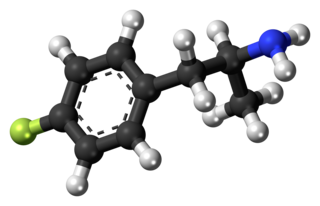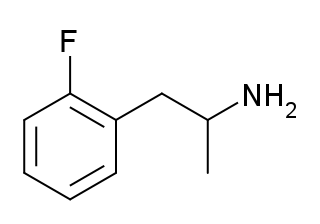
4-Fluoroamphetamine, also known as para-fluoroamphetamine (PFA) is a psychoactive research chemical of the phenethylamine and substituted amphetamine chemical classes. It produces stimulant and entactogenic effects. As a recreational drug, 4-FA is sometimes sold along with related compounds such as 2-fluoroamphetamine and 4-fluoromethamphetamine.

4-Fluoromethamphetamine (4-FMA) is a stimulant drug related to methamphetamine and 4-fluoroamphetamine. It has been reported to be sold as a designer drug, but little is known about its pharmacology or toxicology. It was first detected from legal highs sold in Japan in 2006 and became illegal to sell or to possess for the purpose of distribution in Japan in 2008. It was initially reported to be contained as an ingredient in some of the range of party pills sold internationally by the Israeli company Neorganics from around 2006 onwards, but this was later shown to be incorrect and this ingredient was eventually identified as the closely related compound 2-fluoromethamphetamine.

Phthalimidopropiophenone is a chemical intermediate used in the synthesis of cathinone. It has been found to be sold on the illicit market as a controlled substance analogue, but little is currently known about its pharmacology or toxicology.

Acetildenafil (hongdenafil) is a synthetic drug which acts as a phosphodiesterase inhibitor. It is an analog of sildenafil (Viagra) which has been detected in numerous different brands of "herbal aphrodisiac" products sold in convenience stores that claim to boost libido and alleviate erectile dysfunction.

3',4'-Methylenedioxy-α-pyrrolidinobutyrophenone (MDPBP) is a stimulant of the cathinone class developed in the 1960s, which has been reported as a novel designer drug. MDPBP is sometimes sold under the name "NRG-1" as a mixture with other cathinone derivatives, including flephedrone, pentylone, MαPPP and its higher homologue MDPV. As with other cathinones, MDPBP has been shown to have reinforcing effects in rats.

4'-Methyl-α-pyrrolidinohexiophenone (MPHP) is a stimulant compound which has been reported as a novel designer drug. It is closely related to pyrovalerone, being simply its chain-lengthened homologue. In the pyrrolidinophenone series, stimulant activity is maintained so long as the positions of the aryl, ketone and pyrrolidinyl groups are held constant, while the alkyl backbone can be varied anywhere between three and as many as seven carbons, with highest potency usually seen with the pentyl or isohexyl backbone, and a variety of substituents are tolerated on the aromatic ring.

3-Fluoroamphetamine is a stimulant drug from the amphetamine family which acts as a monoamine releaser with similar potency to methamphetamine but more selectivity for dopamine and norepinephrine release over serotonin. It is self-administered by mice to a similar extent to related drugs such as 4-fluoroamphetamine and 3-methylamphetamine.

2-Fluoroamphetamine (2-FA) is a stimulant drug from the amphetamine family which has been sold as a designer drug. 2-Fluoroamphetamine differs from 3- and 4-fluoroamphetamine in the position of the fluorine atom on the aromatic ring, making them positional isomers of one another. The replacement of a hydrogen atom with a fluorine atom in certain compounds to facilitate passage through the blood–brain barrier, as is desirable in central nervous system pharmaceutical agents, is a common practice due to the corresponding increase in lipophilicity granted by this substitution.

3-Fluoromethcathinone is a chemical compound of the phenethylamine, amphetamine, and cathinone classes that has been sold online as a designer drug. It is a structural isomer of flephedrone (4-fluoromethcathinone).

2-Fluoromethamphetamine (2-FMA) is a stimulant drug of the amphetamine family which has been used as a designer drug. 2-FMA is commonly compared to lisdexamfetamine (Vyvanse), and dextroamphetamine due to its efficacy as a study or productivity aid. 2-FMA is purported to produce somewhat less euphoria than comparable amphetamines, likely due to its main mechanism of action consisting of norepinephrine reuptake inhibition.

Sulfoaildenafil (thioaildenafil) is a synthetic drug that is a structural analog of sildenafil (Viagra). It was first reported in 2005, and it is not approved by any health regulation agency. Like sildenafil, sulfoaildenafil is a phosphodiesterase type 5 inhibitor.

Pentedrone is a stimulant of the cathinone class that has been sold as a designer drug and has been found since 2010 as an ingredient in a number of "bath salt" mixes sold as legal highs.

Acetylfentanyl is an opioid analgesic drug that is an analog of fentanyl. Studies have estimated acetylfentanyl to be 15 times more potent than morphine, which would mean that despite being somewhat weaker than fentanyl, it is nevertheless still several times stronger than pure heroin. It has never been licensed for medical use and instead has only been sold on the illicit drug market. Acetylfentanyl was discovered at the same time as fentanyl itself and had only rarely been encountered on the illicit market in the late 1980s. However, in 2013, Canadian police seized 3 kilograms of acetylfentanyl. As a μ-opioid receptor agonist, acetylfentanyl may serve as a direct substitute for oxycodone, heroin or other opioids. Common side effects of fentanyl analogs are similar to those of fentanyl itself, which include itching, nausea, and potentially fatal respiratory depression. Fentanyl analogs have killed hundreds of people throughout Europe and the former Soviet republics since the most recent resurgence in use began in Estonia in the early 2000s, and novel derivatives continue to appear.

α-Pyrrolidinohexiophenone is a synthetic stimulant drug of the cathinone class developed in the 1960s which has been reported as a novel designer drug.

5F-AMB (also known as 5F-MMB-PINACA and 5F-AMB-PINACA) is an indazole-based synthetic cannabinoid from the indazole-3-carboxamide family, which has been used as an active ingredient in synthetic cannabis products. It was first identified in Japan in early 2014. Although only very little pharmacological information about 5F-AMB itself exists, its 4-cyanobutyl analogue (instead of 5-fluoropentyl) has been reported to be a potent agonist for the CB1 receptor (KI = 0.7 nM).

α-Pyrrolidinopentiothiophenone is a synthetic stimulant of the cathinone class that has been sold online as a designer drug. It is an analogue of α-PVP where the phenyl ring has been replaced by thiophene.

5F-APINACA is an indazole-based synthetic cannabinoid that has been sold online as a designer drug. Structurally it closely resembles cannabinoid compounds from patent WO 2003/035005 but with a 5-fluoropentyl chain on the indazole 1-position, and 5F-APINACA falls within the claims of this patent, as despite not being disclosed as an example, it is very similar to the corresponding pentanenitrile and 4-chlorobutyl compounds which are claimed as examples 3 and 4.

Dimethylone (βk-MDDMA) is a substituted cathinone derivative with stimulant and empathogenic effects. Unlike the corresponding amphetamine derivative MDDM which is thought to be practically inactive, dimethylone substitutes for methamphetamine and MDMA in animal studies and has been sold as a designer drug.

25T7-NBOMe is a substituted phenethylamine derivative from the 25-NB family. It acts as an agonist at the 5-HT2A and 5-HT2C serotonin receptors, has psychedelic effects and has been sold as a designer drug.

3,5-Difluoromethcathinone is a chemical compound from the cathinone family that has been sold as a designer drug, first being identified in Australia in 2009.





















